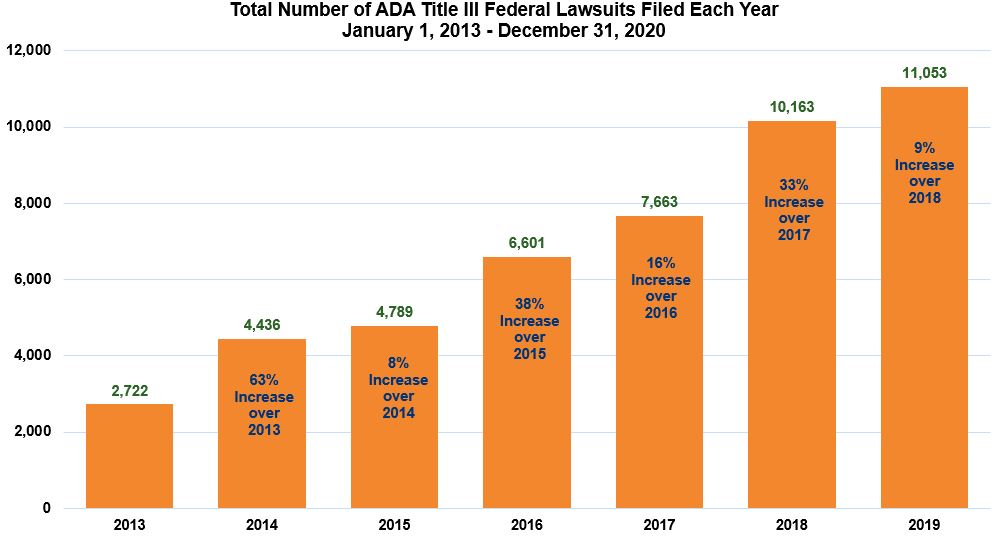
ADA Turns 30 & Evolves In Digital Age
Thirty years ago, on July 26, 1990 Geoge H. W. Bush signed the American Disabilities Act into law. It provided new civil rights that guaranteed equal access and enjoyment of places of public accommodation. At that time the Internet was just budding and the World Wide Web had yet to be born. Luckily the ADA was crafted to evolve with time and technology.
The ADA Evolves With The Digital Age
By establishing that Title iii of the ADA applied to a flexible concept of “places of public accommodation” it’s been able to evolve as intended. Today, as so much of life is experienced in digital spaces, websites and now mobile apps, fall under the definition of such places and thus under the protection of the ADA.
Accessibility Still An Uphill Climb
Whether we speak of the physical or digital word, people with disabilities still experience significant obstacles. As the number of federal lawsuits indicate, the volume of places that continue to be inaccessible is quite substantial.

Graph & content by Seyfarth Shaw Feb 2020
ADA and Website Accessibility
In the past 5 years, the question of whether websites (and now mobile apps) are places of public accommodation has been largely answered with a resounding YES. While the DOJ has declared this, yet not established clear rule making, the courts have filled the gap and overwhelmingly ruled in favor of plaintiffs seeking to force website owners to remove barriers and ensure universal accessibility.
What are the Standards for Website Accessibility?
The Department of Justice is to provide clear standards for compliance of laws, however the DOJ has failed to provide technical rules for what defines ADA compliance. With that said the DOJ was in process and very close to adopting the Web Content Accessibility Guideline (WCAG 2.0 A, AA), however the current administration suspended all rulemaking - despite the call from business groups and advocates alike.
The De Facto Standard for Website Accessibility is the Web Content Accessibility Guideline.
The WCAG is an internationally recognized set of guidelines for digital accessibility. The W3C established and maintains these guidelines. The WCAG is currently in version 2.1 and comes in 3 levels: A, AA, AA. Version 2.1 emerged in 2018 and website owners are now being held to this standard. These are the requirements that virtually all demand letters, federal and state lawsuits, DOJ, and Dept of Education actions have called for. Regardless of how firm this standard may technically be, in practice, if you wish to avoid litigation and wish to make your website accessible, the working standard for digital accessibility in 2020 is WCAG 2.1 A, AA in the United States (and Canada).
WCAG Website Compliance Standards
Web accessibility standards break down to four basic principles: Perceivable, Operable, Understandable, Robust.
- Perceivable - Information and user interface components must be presentable to users in ways they can perceive. This means that users must be able to perceive the information being presented (it can't be invisible to all of their senses)
- Operable - User interface components and navigation must be operable. This means that users must be able to operate the interface (the interface cannot require interaction that a user cannot perform)
- Understandable - Information and the operation of user interface must be understandable. This means that users must be able to understand the information as well as the operation of the user interface (the content or operation cannot be beyond their understanding)
- Robust - Content must be robust enough that it can be interpreted reliably by a wide variety of user agents, including assistive technologies. This means that users must be able to access the content as technologies advance (as technologies and user agents evolve, the content should remain accessible)
Refer to the WCAG 2.1 for details.
Is My Website ADA Compliant?
Unless a website is very specifically designed and built to be accessible and ADA compliant, it simply isn’t. You can verify by testing any page using automated tools such as WebAIM, and be sure to consider that such tools can only detect roughly 30% of WCAG issues… at best.
How Do I Make My Website ADA Compliant?
The path to website accessibility is a two step process. The first step is a website audit and the second step is website remediation based on the audit results.
ADA Web Compliance Audit Best Practices
The best practice is a 3-factor WCAG 2.1 A, AA audit. You cannot rely solely on automated audits because the WCAG is nuanced and interpretive. Automated tools can only detect ~30% of WCAG issues.
- Automated WCAG Testing - Entire website crawl to capture low-hanging fruit
- Manual WCAG Testing - Manual review of code and use-cases for unique pages
- Assistive Technology Testing - Using tools that people with disabilities use for use-cases on unique pages.
The challenge is to find website accessibility experts with deep broad enough experience to be qualified. Such accessibility consultants must have expertise in all of the following in order to provide useful and trusted guidance for remediation.
- The many combinations of use-cases for users with disabilities
- The assistive technologies used by people with disabilities
- The website code
- The WCAG
- The legal awareness of which issues have greatest likelihood of triggering legal actions.
The key is to receive an in-depth WCAG audit report that not only identifies what and where WCAG violations are, but most importantly, how to fix them.
ADA Website Compliance Remediation
With the audit in-hand the design, development, and content teams can break-down the tasks and implement the recommended solutions. If the reporting is good enough, this may be all your team needs. Else, you may also require on-going guidance from an accessibility specialist.
ADA Website Compliance Maintenance
Websites are constantly changing and In order to maintain accessibility, periodic WCAG audits should be scheduled. Until significant changes to the interface are made, you automated auditing tools to check on new pages, products, and blog posts will suffice. Once significant changes are made, manual and assistive technology testing should be conducted on affected pages/templates. More on website accessibility maintenance.
While the path to ADA website compliance may appear daunting. Understand that it can be approached in phases. Please reach out to us and we can help formulate a pragmatic plan that balances the legal risks and the costs to help you reach ADA compliance.